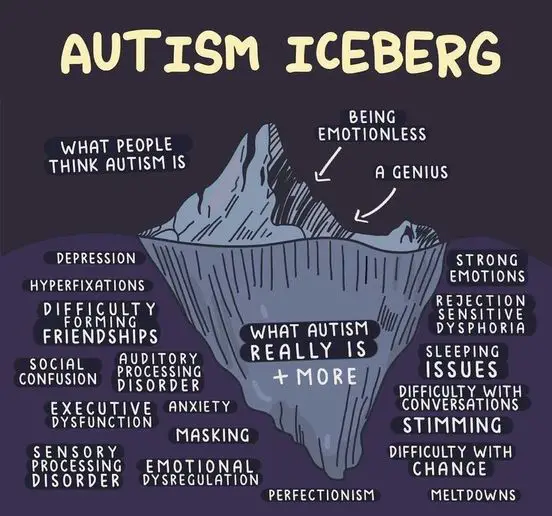How Popular Iceberg Theory Explains Autism Symptoms in Adults
 When you think of autism, you probably picture some of the more outwardly visible traits like difficulties with social interaction, repetitive behaviors, and issues with communication and speech. The stereotypical autistic person might avoid eye contact, have narrow interests, and struggle with back-and-forth conversation.
When you think of autism, you probably picture some of the more outwardly visible traits like difficulties with social interaction, repetitive behaviors, and issues with communication and speech. The stereotypical autistic person might avoid eye contact, have narrow interests, and struggle with back-and-forth conversation.
However, the iceberg theory of autism suggests that the visible signs we typically associate with autism spectrum disorder (ASD) are just the tip of the iceberg. According to this theory, the cognitive abilities and challenges that come with being on the autism spectrum are like an iceberg.
The parts you can see above the water are the more evident social and behavioral symptoms. However, the theory proposes that there is a bigger portion of autism that lies unseen “below the surface.”
Here’s a deeper look at what that submerged portion of the iceberg might contain.
What Lies Beneath Surface Autism Symptoms in Adults?
According to the iceberg theory, the visible social and communication markers represent a relatively small portion of the overall autism experience. Below that surface level, there may be a wide range of difficult-to-observe neurodivergent traits and experiences, including:
Sensory Processing Differences
Many autistic individuals experience atypical sensory processing, which can manifest as over-sensitivity or under-sensitivity to certain sounds, textures, tastes, smells, lights, or touch sensations. This can lead to experiences like sensory overload in stimulating environments.
Executive Functioning Challenges
Executive functions like planning, prioritizing, initiating tasks, and regulating emotions can be extremely difficult for those on the spectrum. These unseen barriers can make everyday activities like getting ready in the morning or completing work assignments very draining.
Intense Special Interests
The ability to develop profound expertise and engage in extremely narrow interests is a hallmark of autism. While these special interests may seem odd or unnecessarily consuming to others, they often bring great joy and depth of knowledge to the autistic individual.
Sleep Issues
Autism is frequently accompanied by struggles falling asleep, staying asleep, or getting quality sleep. Lack of sleep exacerbates many other challenges.
Eating Challenges
Many on the spectrum have very rigid food preferences and aversions. Some may have difficulty with textures, tastes, or the general sensory experience of eating.
Gastrointestinal Problems
A higher-than-typical prevalence of gastrointestinal issues like constipation, diarrhea, and acid reflux disease affects many autistic individuals.
Anxiety and Depression
Anxiety disorders, clinical depression, and other mental health conditions often co-occur with autism, multiplying the daily challenges.
The “Masking” Effect
Additionally, some autistic people learn to consciously or unconsciously “mask” or camouflage their autistic traits when around others in an attempt to fit in more with societal norms and avoid stigmatization. This masking can further hide the depth of their experience from public view.
Looking at this list, it’s clear that the visible social and communication symptoms do not offer a complete picture of autism. Supporting autistic individuals requires looking at and accommodating the fullness of their experience, both the seen and the unseen portions of the metaphorical iceberg.
Uncovering the Value of the Iceberg Theory

For too long, autism has been overly simplified as pure communication and social difficulties. The iceberg theory argues against this reductive, surface-level view. It suggests that a huge portion of the autistic experience—the sensory issues, the intense interests, the struggles with executive functioning—happens underneath the waterline, out of immediate view.
The iceberg theory serves as a reminder that focusing only on the visible “tip” of autism represents just a tiny fraction of the overall picture. Failing to recognize and accommodate the much larger “underwater” portion leads to an incomplete and sometimes even misguided understanding of autism. It pushes individuals to move beyond assumptions based solely on outward behavior and social presentation.
Instead, society should aim to create space for and bring support to those often unseen areas that may be causing difficulty – the sensory needs, the sleep struggles, the mental health challenges, and more.
Examples of How to Support the Full Iceberg of Autism Symptoms in Adults
So how might we take this more comprehensive view and turn it into meaningful support? Here are some examples:
- Accepting and accommodating sensory needs (like noise-canceling headphones or dim lighting)
- Allowing flexibility around strict eating habits or routines
- Looking beneath behavior for possible triggers or underlying issues
- Not over-focusing on “masking” social traits
- Incorporating special interests and bringing talents/abilities to the forefront
- Providing clear schedules, instructions, and structure to offset executive functioning weakness
- Creating emotionally supportive and non-judgmental spaces
- Encouraging self-advocacy and autonomy
- Ensuring ample access to mental health resources and treating co-occurring conditions
The goal is to view autism not as a surface-level social issue, but as a holistic experience that encompasses a complex array of seen and unseen traits and needs. With the iceberg theory as a guide, the community can become better allies and create a more inclusive, accepting world.
Digging Deeper: Iceberg Theory and How It Relates to Autism Symptoms in Adults

Too often, we get caught up focusing solely on the social interaction struggles and communication barriers – which are very real and deserve support and resources. But the iceberg theory is a good reminder that we shouldn’t paint with too broad a brush or oversimplify such a complex neurological condition.
There is an entire rich (and often invisible) world of experiences, neurodivergence, and challenges happening beneath the surface. Viewing autism through this metaphorical iceberg lens helps expand our perspective beyond the obvious signs, and pushes us to truly see and accommodate the whole person.
After all, the visible tip is only a small fraction of the larger iceberg lurking underneath. It’s time we dove deeper.
The Iceberg Metaphor’s Lessons of Autism Symptoms in Adults
The iceberg theory of autism is a powerful metaphor that reframes how we view neurodiversity. By visualizing uniqueness as an iceberg, we are reminded that the outward social and communication difficulties represent just a small portion of the overall experience.
The real bulk of the challenges faced by autistics lurk beneath the surface in the form of sensory processing issues, co-occurring conditions like anxiety and depression, intense interests and expertise, difficulties with executive functioning, and much more.
Keeping this imagery in mind, individuals can avoid making assumptions or judgments based solely on outward behaviors or perceived quirks. The idea that autism is more than its visible markers is not just an academic concept. It needs to translate into how society approaches diagnosis, treatment, accommodations, and societal inclusion.
On a diagnostic level, having such narrowly defined criteria around so-called social deficits means we likely overlook or fail to identify many individuals whose autism manifests in different ways. Embracing the fullness of autism allows for broader, more accurate assessment and recognition of neurodivergence.
In terms of support and resources, the iceberg perspective demands that we craft solutions just as multi-layered and all-encompassing as the autism experience itself. This could mean incorporating more tools for sensory regulation, sleep, anxiety management, and executive functioning into holistic therapies and classroom approaches. It means extending accommodations in schools, workplaces, and communities to areas beyond just social facilitation.
Above all, we must recognize that autism is not a monolith. Like the diversity in the iceberg analogy itself, no two autistic individuals are alike. Each person exists at the unique intersection of visible and invisible traits and challenges.
The iceberg theory simply asks that we look at the whole picture and make space for those above and below the surface. We cannot just acknowledge the tip and consider that a full understanding. There is so much more complexity, individuality, and neurodivergent brilliance waiting to be embraced if we have the perspectives to dive deeper.
My Take on This Analogy
ASD is a mystery for many people, including with autistics ourselves! The iceberg analogy represents the disorder quite well in that you can only see a small part of it peeking out, as most lies under the surface.
This theory helps people understand just how massive and complex autism is because if individuals only look at the surface, there is so much they are missing. If they have a child or loved one with autism, not knowing the depth and uniqueness of the autistic can make it hard for them to understand and connect, so this can be a good first step to learning and understanding.
Understanding autism can be a difficult task but you must learn it because it allows you to connect and empathize with your loved ones with autism, you can understand how they think, communicate, and what they want in life, all to form a deeper bond and a meaningful relationship and that feeling of accomplishing that is priceless.
I actually like the symbol of the mighty iceberg. It’s similar to the “peeling of the onion” analogy of having many layers. As an autistic, I feel strong and proud of my abilities, and even my quirks and uniqueness. It’s made me who I am, and is empowering to know that I’m not a simple read in anyone’s story. Instead, I’m uniquely me, and that’s enough!
If you found this blog helpful, then you might enjoy reading some of the FAQs related to autism. I’d love to hear from you. Just email me at connor@myautismmind.com
Additional FAQs About Autism Spectrum Disorder
- What Are 25 Common Traits of Autism Spectrum Disorder?
- Late-Diagnosis Autism: What Happens When Parents Learn They Also Have ASD?
- Do You Know Your Flavor of Autism Spectrum Disorders?
- Hope for the Future: Will It Transform the Autism World?
- What Are Top 25 Adult Autism Spectrum Disorder Symptoms?
- Am I Neurodivergent? Understanding Neurodiversity and Its Value is Key
- Autism Questions: 6 FAQs You Really Want to Know
- Is Autism A Disability? Surprising Reasons for the Debate
- Alexithymia Symptoms: Is Emotional Blindness A Thing?
- Are We Overly Romanticizing Autism to the Public?
- Defining ASD: What Does It Feel Like?
